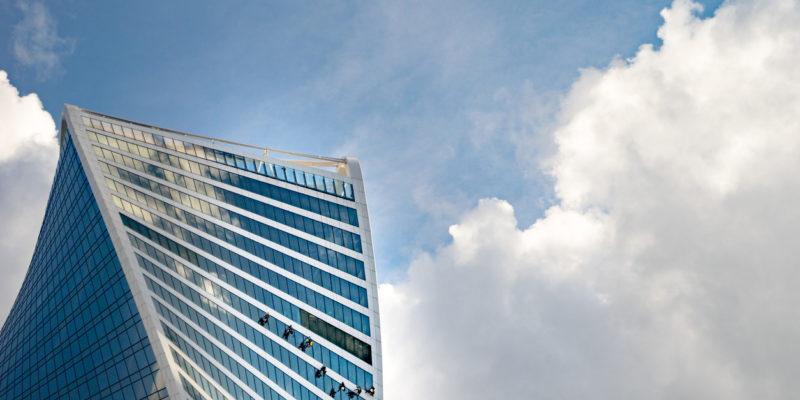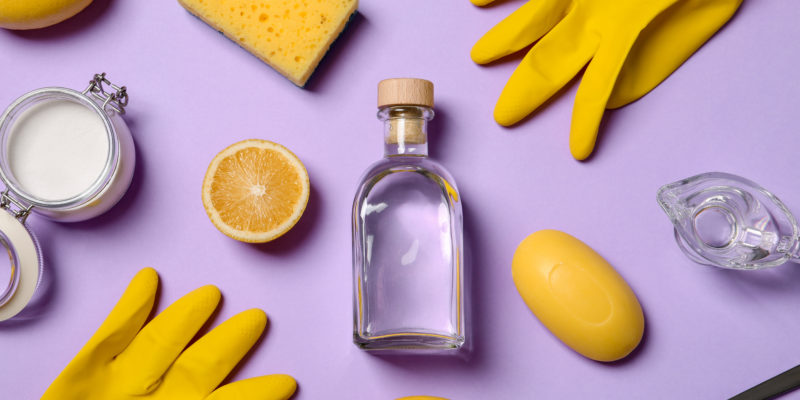The window-cleaning industry is divided into two categories: ground work and suspension work. High-rise window cleaning involves buildings over four-stories tall. Workers are suspended from the top of the building or work from elevated scaffolding erected on the exterior of the building. Depending on the nature of the operation, workers can be faced with various safety hazards.
Safety must be paramount for high-rise window cleaners, as any accident that happens several stories off the ground will have catastrophic consequences. The responsibility of ensuring the safety of the window cleaners rests with all parties involved in the window cleaning operation. This includes the contractor, the workers and the building manager.
Extensive High-rise Training and Certification
Like most dangerous jobs, high rise window cleaning requires comprehensive training. Workers must have a comprehensive knowledge of what equipment to use, understand the safety features of the equipment and how to use it effectively. Additionally, workers must be highly skilled and comfortable at working at heights.
Medical Examinations
Due to the extreme height of buildings, with many over 50 stories high, workers must be checked for any medical conditions that could possibly interfere with their work performance. Conditions that could affect performance, and safety, when working at extreme height include balance issues, epilepsy, high or low blood pressure, diabetes and impaired limb function.
Safety Lines and Anchors
Workers must wear a safety harness around their chest or chest & legs that is connected to both a working and safety line. These ropes are typically adjacent to one another. A backup safety-line adjustment device prevents a fall if a worker slips, loses control or the main working harness line fails. A “descender” allows the worker to get down safely by gently lowering the worker to the ground in case of a slip or fall.
Safety anchors should be connected to the sides of the buildings before cleaning building windows. Anchors typically will have been tested for a safety rating load of 1,000 pounds. The safety and main lines typically go through eye holes in the anchor and are designed to help prevent accidents if a bolt comes loose. Anchors are tested at least once every year.
Site Assessment
One of the most critical aspects of job safety during high-rise window cleaning operations is the ability to identify and assess workplace hazards. Site assessment identifies the safety hazards workers may run into at a job site. A model job-site evaluation plan can be found on the International Writing Centers Association website. Here are the major workplace safety hazards that are evaluated as part of the site assessment:
Weather: Weather conditions must be constantly monitored during any active window-cleaning operations. Professional high-rise window cleaning requires workers to be outside in various weather conditions. As such, inclement weather conditions that include extreme hot and cold temperatures, precipitation, lightning and wind conditions are all taken into account. Due consideration has to be given whenever a wind speed of 15 miles per hour or greater is present. Exterior high rise window cleaning should not take place whenever there are sustained wind speeds in excess of 25 miles per hour.
Personal Protective Gear: Window cleaners can be exposed to a variety of chemical-cleaning products. They must wear appropriate protective gear, such as gloves, eye protection and possibly respirators, depending on what chemicals are being used on a particular job. A helmet helps protect the workers head from injury in the event of a fall as well as from objects that may fall from above the work area. Appropriate work boots with steel toes protect worker’s feet from slipping, chemical exposures and impacts. High-visibility clothing allows others to readily notice the workers.
Tripping and Falling Hazards: Falls are the primary hazard faced by commercial window cleaners and crews working on high-rise buildings face increased fall hazards. The greatest fall hazard exists when working on surfaces without adequate edge protection. Edge protection includes a guardrail or a structural parapet a minimum of 42 inches high.
Changes in elevation of work surfaces greater than four feet that are not protected by a structure 42 inches or taller, such as a guardrail, can pose tripping hazards. Tripping hazards can include, but are not limited to, scaffolding and skylights and dissimilar roof heights, balconies and unprotected holes and retaining walls on the ground.
Cleaners can reach away from their body to clean a window, provided only their upper body is extended past the edge of the structure they are standing on and both feet are set firmly on said structure. Body weight should never be supported by a window or window frame when reaching out to clean.
Ladders: Job-site conditions may dictate the need for ladders. Crews must use the appropriate type of ladder, such as an extension vs. a step ladder, for the appropriate conditions.
Electrical: Workers must be constantly aware of electrical hazards to avoid shock or electrocution. This requires maintaining a minimum 10-foot distance from all exposed outlets, electrical fixtures, power and supply lines in the work area. Ladders, water-fed and extension poles shouldn’t be extended to a height to allow these devices to come within 10 feet of power lines or power supply devices.
People: Others, such as building occupants, co-workers and members of the public, will usually be present during most types of high-rise window cleaning work. Crews must be aware of their presence to both protect themselves as well as anyone else that may be in the work area and impact safety.
Emergency Situations: At least one person on an active job site should have full training in basic first aid. All entryways and exits must be identified and an emergency evacuation plan must be in place. An emergency plan must be in place whenever working in earthquake-prone areas.
Types of Insurance Coverage
Employees of window washing companies face more potential risks than most other occupations. Even when all safety protocols are in place and followed to the letter, due to the inherent risky nature of high rise window cleaning, adequate insurance must be in place when cleaning building windows to protect workers, business owners and the public. Here is a breakdown of the most common types of window-cleaning coverage:
Bodily-Injury Coverage: A component of general-liability insurance, bodily injury insurance will cover members of the public or building workers who are injured during window-cleaning operations. Bodily-injury insurance will cover their medical and related expenses.
Property Damage: This covers damage to a customer’s property cause by window washers.
Completed Operations Coverage: This insurance covers liability if someone is harmed by a product or services that has been rendered. For example, if a worker used a cleaning solution that scratched the windows the owner could sue for damages.
Workers Compensation: This is standard coverage that will pay for any necessary medical care and associated costs and expenses if an employee is injured on the job.
In Conclusion, a high-rise window cleaning company should take all the necessary precautions to have their employees safe. Here at Window Cleaning Miami, we are licensed and certified high-rise window cleaners. Trust us to complete jobs on time and in a safe manner. Call us today!


